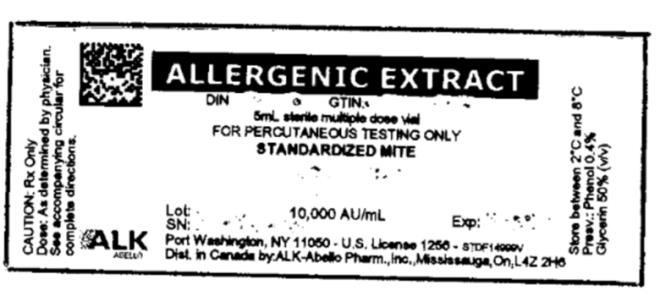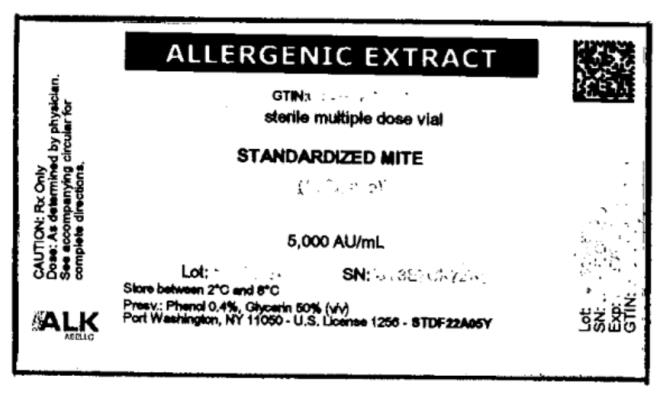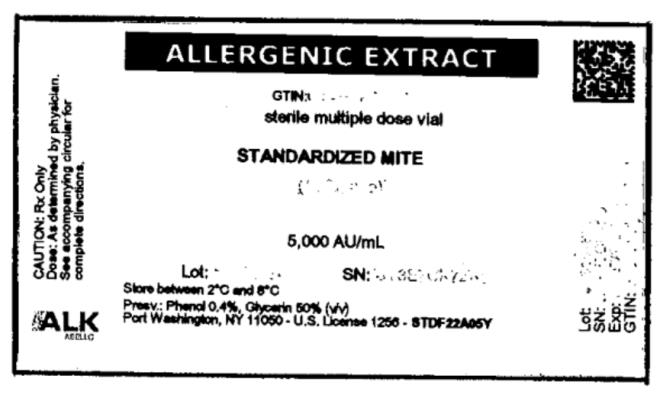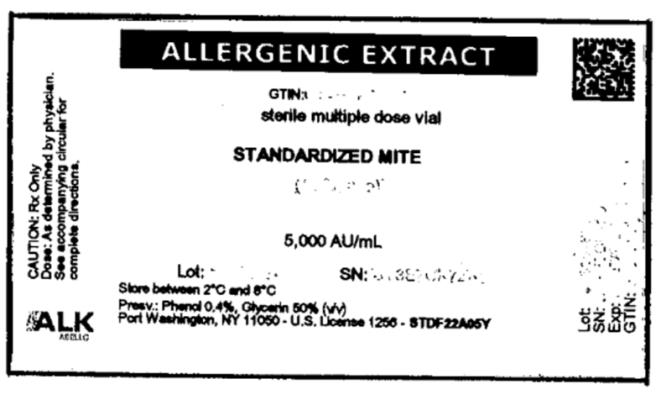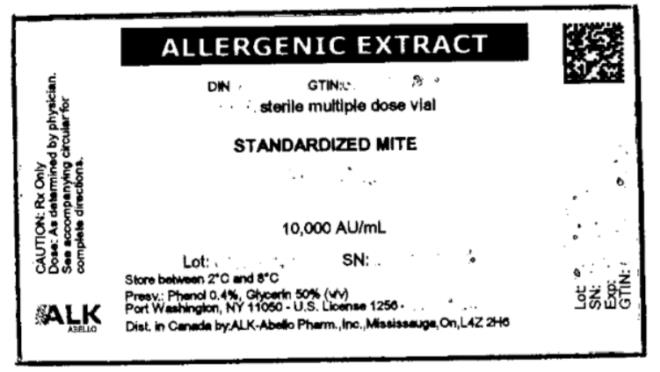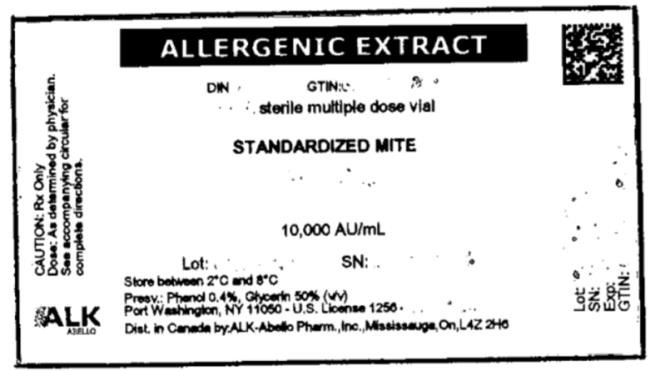Label: STANDARDIZED MITE, MIXED injection, solution
- NDC Code(s): 0268-7002-10, 0268-7002-30, 0268-7002-50, 0268-7003-30
- Packager: ALK-Abello, Inc.
- Category: STANDARDIZED ALLERGENIC
Drug Label Information
Updated February 25, 2020
If you are a healthcare professional or from the pharmaceutical industry please visit this version.
- Download DRUG LABEL INFO: PDF XML
- Official Label (Printer Friendly)
- SPL UNCLASSIFIED SECTION
-
BOXED WARNING
(What is this?)
WARNINGS
Standardized allergenic extract is intended for use by physicians who are experienced in the administration of standardized (AU/mL) allergenic extracts for immunotherapy and the emergency care of anaphylaxis, or for use under the guidance of an allergy specialist. Standardized allergenic extracts are not directly interchangeable with allergenic extracts of the same labeled potency from different manufacturers. The patient must be re-evaluated with the newly selected extract. The initial dose must be based on skin testing as described in the dosage and administration section of this insert. Patients being switched from other types of extracts to standardized allergenic extracts should be started as though they were coming under treatment for the first time. Patients should be instructed to recognize adverse reaction symptoms and cautioned to contact the physician's office if reaction symptoms occur. As with all allergenic extracts, severe systemic reactions may occur. Patients with unstable asthma or steroid dependent asthmatics and patients with underlying cardiovascular disease are at greater risk. In certain individuals, these life-threatening reactions may result in death. Patients should be observed for 20 to 30 minutes following treatment, and emergency measures, as well as personnel trained in their use, should be immediately available in the event of a life-threatening reaction.
This product should not be injected intravenously. Deep subcutaneous routes have proven to be safe. See the warnings, precautions, adverse reactions and over-dosage sections below.
Sensitive patients may experience severe anaphylactic reactions resulting in respiratory obstruction, shock, coma and/or death.
Patients receiving beta-blockers may not be responsive to epinephrine or inhaled bronchodilators. Respiratory obstruction not responding to parenteral or inhaled bronchodilators may require theophylline, oxygen, intubation and the use of life support systems. Parenteral fluid and/or plasma expanders may be utilized for treatment of shock. Adrenocorticosteroids may be administered parenterally or intravenously. Refer to the warnings, precautions and adverse reaction sections below.
Adverse events are to be reported to MedWatch (1-800-FDA-1088), Adverse Event Reporting, Food and Drug Administration, 5600 Fishers Lane, Rockville, MD 20852-9787.
- SPL UNCLASSIFIED SECTION
-
DESCRIPTION
Allergenic Extract Standardized Mite in the accompanying vial is a sterile solution and contains glycerin 50% v/v and phenol 0.4% (preservative). Inert ingredients include sodium chloride for isotonicity and sodium bicarbonates, as a buffer. The mites (D. farinae and/or D. pteronyssinus),
used as source material for this extract, were cultured by Biopol Laboratories on a medium consisting of yeast and pork. The whole-body mites were separated from the culture medium and the harvested mites contained less than 1% culture medium material.
Several manufacturers submitted to FDA, intradermal skin test data on Biopol Laboratory’s mite medium extract using patients who were puncture test positive (sum of erythema equal to or greater than 40 mm) to either D. farinae or D. pteronyssinus extracts. By intradermal testing, there was 1 positive (sum of erythema equal to or greater than 20 mm) in 44 individuals at an estimated 1% level of medium contamination of mites, and 4 positives in 40 individuals at an estimated 10% contamination. Two of the individuals who were skin test positive also skin tested by the puncture method with an extract of yeast (Saccharomyces sp) and were positive.
In ten mite sensitive patients, ALK-Abelló, Inc. observed no puncture or intradermal reactions to media from the same source at a carryover concentration equivalent to 1% of the mite extract.
For ease in use, and for lot to lot consistency, potency value is expressed in allergy units per milliliter.
This ELISA standardized mite extract was compared to a mite reference preparation supplied by FDA which was labeled 10,000 AU/mL based on skin testing.1 The relative potency of this mite extract was determined by ELISA inhibition in comparison to the FDA Mite reference and is labeled in AU's (Allergy Units/mL).2 Dilutions made from this product can be administered intradermally for testing, or subcutaneously for immunotherapy.
-
CLINICAL PHARMACOLOGY
Diagnostically (for skin testing) the allergen combines with IgE antibodies fixed to mast cells in the skin.3 This complexing causes an increase in cellular permeability and degranulation of the mast cells releasing chemical mediators. These mediators (such as histamine) are responsible for a local inflammatory response of wheal and erythema typical of a positive skin test reaction and also, the symptoms commonly associated with allergic disease. The more mediator release, the larger the reaction (wheal and erythema).
Treatment consists of the subcutaneous injection of gradually increasing doses of the allergens to which the patient is allergic. It has been demonstrated that this method of treatment induces an increased tolerance to the allergens responsible for the symptoms on subsequent exposure. Although the exact relationships between allergen, skin sensitizing antibody (IgE) and the blocking antibody (IgG) have not been precisely established, clinically confirmed immunological studies have adduced evidence of the efficacy of hyposensitization therapy.
Numerous controlled studies have demonstrated the clinical efficacy of immunotherapy with cat, dust mites and some pollen extracts.4 Nevertheless, responses are not uniform but variable, and in a few studies, the majority of the patients reported no appreciable improvement.
-
INDICATIONS AND USAGE
This product is indicated for the diagnosis and treatment of hypersensitivity in patients with symptoms compatible with dust mite allergy.
Hyposensitization (injection) therapy is a treatment for patients exhibiting allergic reactions to seasonal pollens, dust mites, molds, animal danders, and various other inhalants, in situations where the offending allergen cannot be avoided. Mixtures of standardized mite (D. farinae and D. pteronyssinus) should be considered for treatment of patients who are sensitive to both species.
Prior to the initiation of therapy, clinical sensitivity should be established by careful evaluation of the patient's history confirmed by diagnostic skin testing. Hyposensitization should not be prescribed for sensitivities to allergens which can be easily avoided.
-
CONTRAINDICATIONS
There are no known absolute contraindications to immunotherapy. However, a patient should not be immunized with preparations of allergens to which the patient has not demonstrated symptoms and positive skin tests. In most cases, immunotherapy is not indicated for those allergens that can be eliminated or minimized by environmental control.
Also, there is some evidence, although inconclusive, that routine immunizations may exacerbate autoimmune diseases.5,6,7 Hyposensitization should be given cautiously to patients with this predisposition. Patients with severe cardiorespiratory symptoms are at additional risk during a systemic reaction. The physician must weigh the risk to benefit in these cases.
Patients on beta-blockers are not candidates for immunotherapy, as they can be non-responsive to beta-agonists that may be required to reverse a systemic reaction. Also, see BOXED WARNING section.
In the presence of active symptoms such as rhinitis, wheezing, dyspnea, etc., the indications of immunotherapy must be weighed carefully against the risk of temporarily aggravating the symptoms by the injection itself.
-
WARNINGS
See warnings at the beginning of this package insert. Standardized allergenic extracts are not directly interchangeable with allergenic extracts of the same labeled potency from different manufacturers. The patient must be re-evaluated with the newly selected extract.
A reduction in starting dose is recommended in the following circumstances:
- Changing to a new lot of extract from the same manufacturer
- Using product from a different manufacturer
- Using non-standardized extract or any other change in formula
- Changing to a product bearing a later expiration date
- When a prolonged lapse in time has occurred since the last injection
Withhold allergenic extracts temporarily or reduce the dose in patients with any one of the following conditions:
- Severe rhinitis or asthma symptoms;
- Infection or flu accompanied by fever;
- Exposure to excessive amounts of clinically relevant allergen prior to therapy.
Allergenic extracts slowly become less potent with age. During the course of treatment, it may be necessary to continue therapy with a vial of extract bearing a later expiration date. The initial dose of the extract bearing the later expiration date should be lowered to a safe non-reaction-eliciting level. When switching one standardized extract with another, at least 75% reduction in dose is suggested.
Patients should always be observed for at least 20 to 30 minutes after any injection. In the event of a marked systemic reaction such as urticaria, angioedema, wheezing, dyspnea, respiratory obstructions, hypotension and coma, application of a tourniquet above the injection site and administration of 0.2 mL to 1.0 mL (0.01 mg/kg) of Epinephrine Injection (1:1000) is recommended. Maximal recommended dose for children between 2 and 12 years of age is 0.5 mL. The tourniquet should not be left in place without loosening for 90 seconds every 15 minutes. Patients under treatment with beta-blockers may be refractory to the usual dose of epinephrine.
Volume expanders and vasopressor agents may be required to reverse hypotension. Inhalation bronchodilators and parenteral aminophylline may be required to reverse bronchospasm. In cases of respiratory obstruction, oxygen and intubation may be necessary. Life-threatening reactions unresponsive to the above may require cardiopulmonary resuscitation. DO NOT GIVE INTRAVENOUSLY.
Mite Extracts (D. farinae and/or D. pteronyssinus) contain small (<1%) amounts of residual media components (pork and yeast). The physician should proceed with caution when using mite extract in mite sensitive individuals that also demonstrate sensitivity to these media components and only if clearly warranted.
In the presence of active symptoms such as rhinitis, wheezing, dyspnea, etc., the indications of immunotherapy must be weighed carefully against the risk of temporarily aggravating the symptoms by the injection itself. If the protective action of allergenic extract injections is considered essential for the patient's welfare, appropriate symptomatic therapy with antihistaminic, adrenergic or other drugs might be needed either prior to or in conjunction with allergenic extract injections.
- Changing to a new lot of extract from the same manufacturer
-
PRECAUTIONS
INFORMATION TO PATIENTS:
Patients should be instructed to describe any active allergic symptoms such as rhinitis, wheezing, dyspnea, etc., prior to injection including any late reactions from previous administration. Patients should remain in doctor's office for 20-30 minutes following injections and be instructed to report any local or systemic symptoms before leaving. Also, see ADVERSE REACTIONS and WARNINGS Sections.
If the protective action of allergenic extract injections is considered essential for the patient's welfare, appropriate symptomatic therapy with antihistaminic, adrenergic or other drugs might be needed either prior to or in conjunction with the allergenic extract injections.
GENERAL
- Store allergenic extracts between 2o - 8oC at all times, even during use.
- Use sterile precautions. Using a sterile tuberculin syringe, injections are given subcutaneously. A separate syringe must be used for each patient to prevent transmission of hepatitis and other infectious disease.
- Care must be taken to avoid injecting into a blood vessel. Pull gently on syringe plunger to determine if a blood vessel has been entered (See Warnings).
- Extracts in 50% glycerin can cause discomfort at the site of the injection during the injection.
- Standardized concentrates of allergenic extracts must be diluted prior to initiation of immunotherapy.
- Dilute allergenic extracts may be more potent when diluted with Albumin saline than those which do not contain stabilizers such as albumin.
PREGNANCY - CATEGORY C:
Animal reproduction studies have not been conducted with allergenic extracts. It is also not known whether allergenic extracts can cause fetal harm when administered to a pregnant woman or can affect reproduction capacity.
Controlled studies of hyposensitization with moderate to high doses of allergenic extracts during conception and all trimesters of pregnancy have failed to demonstrate any risk to the fetus or to the mother. However, on the basis of histamine's known ability to contract the uterine muscle, the release of significant amounts of histamine from allergen exposure of hyposensitization overdose should be avoided on theoretical grounds. Therefore, allergenic extracts should be used cautiously in a pregnant woman, and only if the benefit outweighs the risk.
PEDIATRIC USE:
Children can receive the same dose as adults, however, to minimize the discomfort associated with dose volume it may be advisable to reduce the volume of the dose by half and administer the injection at two different sites.
GERIATRIC USE:
Studies in geriatric patients have not been conducted. Physicians should consider risk to benefit of immunotherapy in this patient population.
NURSING MOTHERS:
It is not known if allergens administered subcutaneously appear in human milk. Because many drugs are excreted in human milk, caution should be exercised when allergenic extracts are administered to a nursing woman.
CARCINOGENESIS, MUTAGENESIS, IMPAIRMENT OF FERTILITY:
Long term studies in animals have not been performed.
DRUG INTERACTIONS:
Drugs can interfere with the performance of skin tests.8
Antihistamines: Response to mediator (histamine) released by allergens is suppressed by antihistamines. The length of suppression varies and is dependent on individual patient, type of antihistamine and length of time the patient has been on antihistamines. The duration of this suppression may be as little as 24 hours to several days.
Tricyclic Antidepressants: These exert a potent and sustained decrease of skin reactivity to histamine which may last for a few weeks.
Beta2 Agonists: Oral terbutaline and parenteral ephedrine, in general, have been shown to decrease allergen induced wheal.
Dopamine: Intravenous infusion of dopamine may inhibit skin test responses.
Beta Blocking Agents: Propranolol can significantly increase skin test reactivity (See WARNINGS).
Other Drugs: Short acting steroids, inhaled beta2 agonists, theophylline and cromolyn do not seem to affect skin test response.
- Store allergenic extracts between 2o - 8oC at all times, even during use.
-
ADVERSE REACTIONS
Local: Reactions at the site of injection may be immediate or delayed. Immediate wheal and erythema reactions are ordinarily of little consequence, but if very large, may be the first manifestation of systemic reaction. If large local reactions occur, the patient should be observed for systemic symptoms for which treatment is outlined below. However, systemic reactions may occur in the absence of large local reactions.
Delayed reactions start several hours after injection with local edema, erythema, itching or pain. They are usually at their peak at 24 hours and usually require no treatment. Antihistamine drugs may be administered orally.
The next therapeutic dose should be reduced to the dose which did not elicit a reaction, and subsequent doses increased more slowly, i.e., use of intermediate dilutions.
Systemic: Reports from regulatory authorities in Sweden to the FDA, indicated that several deaths have been associated with the use of mite extracts. The FDA was subsequently informed that these deaths may have been related to use by physicians untrained in the administration of potent extracts rather than a product defect. It should be noted that anaphylaxis and deaths following the injection of mite and other extracts have also been reported by The British Committee on Safety in Medicine.9 Fatalities from immunotherapy in the United States since 1945 have been extensively reviewed by Lockey, R F, et al10, Reid M J et al.11 and more recently by Bernstein, D. I. et al23 . With careful attention to dosage and administration, such reactions occur infrequently, but it must be remembered that allergenic extracts are highly potent to sensitive individuals and OVERDOSE could result in anaphylactic symptoms. Therefore, it is imperative that physicians administering allergenic extracts understand and be prepared for the treatment of severe reactions.
Systemic reactions are characterized by one or more of the following symptoms: Sneezing, mild to severe general urticaria, itching other than at the injection site, extensive or generalized edema, wheezing, asthma, dyspnea, cyanosis, hypotension, syncope and upper airway obstruction. Symptoms may progress to shock and death. Patients should always be observed for 20 to 30 minutes after any injection. Volume expanders and vasopressor agents may be required to reverse hypotension. Inhalational bronchodilators and parenteral aminophylline may be required to reverse bronchospasm. Severe airway obstruction, unresponsive to bronchodilator, may require tracheal intubation and use of oxygen. In the event of a marked systemic reaction, application of a tourniquet above the injection site and the administration 0.2 mL to 1.0 mL of Epinephrine Injection (1:1000) is recommended. Maximal recommended dose for children under 2 years of age is 0.3 mL. Maximal recommended dose for children between 2 and 12 years of age is 0.5 mL. The tourniquet should not be left in place without loosening for 90 seconds every 15 minutes.
The next therapeutic injection of extract should be reduced to the dose which did not elicit a reaction, and subsequent doses increased more slowly, i.e., use of intermediate dilutions.
- OVERDOSE
-
DOSAGE AND ADMINISTRATION
Parenteral drug products should be inspected visually for particulate matter and discoloration prior to administration whenever solution and container permit.
When diluting bulk extracts, use of either Sterile Diluent for Allergenic Extracts or Sterile Diluent for Allergenic Extracts Normal Saline with HSA is recommended. Dilutions should be made with sterile disposable syringes using aseptic technique. Commonly 10 fold dilutions are used to achieve a desired concentration for intradermal testing or initiation and continuation of immunotherapy. For example, transferring 0.5 mL of a 10,000 AU/mL extract into 4.5 mL of diluent will yield 5 mL of extract @ 1,000 AU/mL. Prepare as many additional serial dilutions as necessary to reach the appropriate concentration.
Care should be exercised to avoid cross contamination of allergens if mixing with other allergenic extracts. The use of separate syringes for each allergen and diluent when compounding patient mixes is recommended.
Diagnosis - In diagnosing the sensitive individual, the symptom history must be associated with exposure to the allergen. Skin testing is used in conjunction with a definitive history for diagnosing individual sensitivities.
An excellent method of recording results is to cover the skin reaction with transparent tape, outline the erythema first then the wheal with an indelible pen, then remove the tape and transfer it to the patient's permanent record. For preferred results, it is recommended that the actual measurement of the extent of both responses be recorded. This can be accomplished by measuring the longest erythema diameter, then selecting the mid - point of that line and measuring at a 90○ angle to that line to determine the orthogonal diameter. The sum of these two measurements is the sum of erythema (ƩE); the sum of wheal diameters is determined in a similar manner.
Patient's response is graded on the basis of the size of erythema and/or wheal.
Percutaneous (prick/scratch/puncture) test:
Prick, scratch, or puncture skin tests should be performed initially using an extract specially made for this purpose. The usual dose is one drop.
In a skin test study of 10 patients who were determined to be allergic to mite (D. farinae), the mean puncture test (using a bifurcated needle) to a solution containing 10,000 AU/mL had a sum of erythema of 73 mm (range 43 - 138 mm) and a sum of wheal of 17 mm (range 7 - 31 mm).
In another skin test study of 11 patients who were determined to be allergic to mite (D. pteronyssinus), the mean puncture test (using a bifurcated needle) to a solution containing 10,000 AU/mL had a sum of erythema of 84 mm (range 56 - 112 mm) and a sum of wheal of 20 mm (range 7 - 33 mm).
What follows are general guidelines for percutaneous testing. Different devices and/or techniques influence the size of the reaction, therefore it is important to refer to the device manufacturer's or distributor's instructions when grading reactions.
0 No wheal. Erythema absent or very slight (not more than 1 mm in diameter).
+ Wheal absent or very slight erythema present (not more than 3 mm diameter).
++ Wheal not more than 3 mm diameter, or erythema not more than 5 mm diameter.
+++ Wheal between 3 mm and 5 mm in diameter with erythema. Possible pseudopodia and itching.
++++ Any larger reaction with itching and possible pain.
Intradermal test:
On the forearm or upper outer aspect of the arm, using a 26 - 27 gauge, short bevel needle, inject intradermally .05 mL of the intradermal test solution. Skin whealing responses should be observed 10 - 20 minutes after administering the test.
In a skin test study of the 10 mite puncture reactive patients (D. farinae) described above, the mean intradermal dose for ƩE = 50 mm was 0.01 AU/mL ( range = <0.0003 to 0.4 AU/mL).
In the skin test study of the 11 mite puncture reactive patients (D. pteronyssinus) described above, the mean intradermal dose for ƩE = 50 mm was 0.006 AU/mL ( range = <0.0007 to 0.05 AU/mL).
Intradermal testing should start with a dilute solution, usually in the range of 1 AU or less.
Glycerinated extracts diluted for intradermal testing may be diluted at least 25 fold to less than 2% glycerin (by volume) as glycerin above this level can cause false positive intradermal skin tests.
A negative skin test is one where the sum of erythema was 0 or equal to the sum of the wheal. As a negative control, the diluent should be tested and included in the interpretation of the skin reactions.
0 No increase in size of bleb since injection. No erythema.
+ An increase in size of bleb and a wheal not more than 5 mm diameter with associated erythema.
++ Wheal between 5 mm and 8 mm in diameter with erythema.
+++ Wheal between 8 mm and 12 mm in diameter with erythema and possible pseudopodia, itching or pain.
++++ Any larger reaction with itching and pain and possible diffuse blush of the skin surrounding the reaction area.
Immunotherapy - Starting dose for immunotherapy is related directly to a patient's sensitivity as determined by carefully executed skin testing. Degree of sensitivity can be established by determination of D50 (the intradermal dose, base three, that produces a ƩE = 50 mm).1
A general rule is to begin at 1/10 of the dose that produces sum of erythema of 50 mm (approximately a 2+ positive skin test reaction). For example, if a patient exhibits a 2+ intradermal reaction to
1 AU/mL, the first dose should be no higher than 0.05 mL of 0.1 AU/mL. Dosage may be increased by 0.05 mL each time until 0.5 mL is reached, at which time the next 10-fold more concentrated dilution can be used, beginning with 0.05 mL, if no untoward reaction is observed. (See beginning of DOSAGE AND ADMINISTRATION section for instructions in preparing dilutions of concentrates.)
If a tolerated dose of allergenic extract has been established, the initial dose from the new extract should be reduced by 75% of the previously well tolerated dose (see also Precautions).
Interval between doses in the early stages of immunotherapy is no more than once to twice a week, and may gradually be increased to once every two weeks. Generally, maintenance injections may be given as infrequently as once every two weeks to once a month. The progress of patients on immunotherapy should be closely monitored. If improvement is realized a usual course of treatment may be from 3 to 5 years. If progress is unsatisfactory for a year or more, discontinuation of immunotherapy should be considered.
Injections are given subcutaneously preferably in the arm. It is advantageous to give injections in alternate arms and routinely in the same area. In some patients, a local tolerance to the allergen may develop thus preventing a possible severe local reaction.
After inserting the needle, but before injecting the dose, pull plunger of the syringe slightly, if blood returns in the syringe, discard the syringe and contents and repeat injection at another site.
Bulk concentrated extracts must be diluted for initial therapy and intradermal skin testing. For recommended diluent, refer to the beginning of the DOSAGE AND ADMINISTRATION section.
Use standard aseptic precautions when making dilutions. The first dose of the new extract should be reduced at least 50% - 75% of the amount of the dosage from the previous extract.
Stability studies for diluted and undiluted forms of this product are not complete. Indications are the undiluted product will retain its potency under recommended storage conditions at least until the expiration date on the vial label is reached. It is recommended that minimal amounts of the concentrate be diluted so that the diluted product is used up within a relatively short period of time, i.e., preferably not more than four weeks.
- HOW SUPPLIED
-
REFERENCES
1Turkeltaub, P. C. et al. Office of Biologics Research and Review skin test method for evaluation of subject sensitivity to standardized allergenic extracts and for assignment of allergy units to reference preparations using the ID50EAL method. FDA OBRR Methods of the Allergenic Products Branch. 1986.
2 Anon. ELISA Competition Assay: Quantitative determination of relative potency of Allergenic Extracts. FDA CBER Methods of the Allergenics Products Testing Laboratory. 1993.
3 Norman, P. S. The clinical significance of IgE. Hosp. Prac. 1975; 10:41-49.
4 VanMetre, T. E. and Adkinson, N. F. Immunotherapy for aeroallergen disease. In: Middleton et al. Allergy Principles and Practice 3rd Ed. St. Louis: CV Mosby, 1988:1327.
5 Umetsu, D. T. et al. Serum sickness triggered by anaphylaxis: a complication of immunotherapy. J. Allergy Clin. Immunol. 1985; 76:713.
6 Phannphak, P. and Kohler, P. F. Onset of polyarteritis nodosa during allergic hyposensitization treatment. Am. J. Med. 1980; 68:479.
7 Kohler, P. F. Immune complexes and allergic disease. In: Middleton et al. Allergy Principles and Practice 3rd Ed. St. Louis: CV Mosby, 1988:167.
8 Bousquet, J.: In vivo methods for the study of allergy: skin test, techniques, and interpretation. In: Middleton et al: Allergy Principles and Practice 3rd Ed. St. Louis: CV Mosby, 1988:167.
9 Committee on the Safety of Medicines. CSM update: desensitizing vaccines. Brit. Med. J. 1986; 293:948.
10 Lockey, R. F. et al. Fatalities from immunotherapy(IT) and skin testing (ST). J. Allergy Clin. Immunol. 1987; 79:660.
11 Reid M J et al. Survey of fatalities from skin testing and immunotherapy 1985-1989. J. Allergy Clin. Immunol. 1993; 92:6.
12Bernstein DI, Wanner M, Borish L, Liss GM: Immunotherapy Committee, American Academy of Allergy, Asthma and Immunology. Twelve-year survey of fatal reactions to allergen injections and skin testing: 1990-2001. J Allergy Clin Immunol. 204 Jun;113(6):1129-36.
Distributed in Canada by:
Alk-Abelló Pharmaceuticals, Inc.
#35-151 Brunel Road
Mississauga, Ontario Canada, L4Z 2H6
Revision: July 2016
©ALK-Abelló, Inc. 188L
- PRINCIPAL DISPLAY PANEL
- PRINCIPAL DISPLAY PANEL
- PRINCIPAL DISPLAY PANEL
- PRINCIPAL DISPLAY PANEL
- PRINCIPAL DISPLAY PANEL
- PRINCIPAL DISPLAY PANEL
-
INGREDIENTS AND APPEARANCE
STANDARDIZED MITE, MIXED
standardized mite, mixed injection, solutionProduct Information Product Type STANDARDIZED ALLERGENIC Item Code (Source) NDC:0268-7002 Route of Administration SUBCUTANEOUS Active Ingredient/Active Moiety Ingredient Name Basis of Strength Strength DERMATOPHAGOIDES FARINAE (UNII: PR9U2YPF3Q) (DERMATOPHAGOIDES FARINAE - UNII:PR9U2YPF3Q) DERMATOPHAGOIDES FARINAE 10000 [AU] in 1 mL DERMATOPHAGOIDES PTERONYSSINUS (UNII: 57L1Z5378K) (DERMATOPHAGOIDES PTERONYSSINUS - UNII:57L1Z5378K) DERMATOPHAGOIDES PTERONYSSINUS 10000 [AU] in 1 mL Inactive Ingredients Ingredient Name Strength SODIUM CHLORIDE (UNII: 451W47IQ8X) 0.005 mg in 1 mL SODIUM BICARBONATE (UNII: 8MDF5V39QO) 0.0027 mL in 1 mL GLYCERIN (UNII: PDC6A3C0OX) 0.5 mg in 1 mL PHENOL (UNII: 339NCG44TV) 0.004 mg in 1 mL HYDROCHLORIC ACID (UNII: QTT17582CB) SODIUM HYDROXIDE (UNII: 55X04QC32I) Packaging # Item Code Package Description Marketing Start Date Marketing End Date 1 NDC:0268-7002-10 10 mL in 1 VIAL; Type 0: Not a Combination Product 2 NDC:0268-7002-30 30 mL in 1 VIAL; Type 0: Not a Combination Product 3 NDC:0268-7002-50 50 mL in 1 VIAL; Type 0: Not a Combination Product Marketing Information Marketing Category Application Number or Monograph Citation Marketing Start Date Marketing End Date BLA BLA103060 07/08/1991 STANDARDIZED MITE, MIXED
standardized mite, mixed injection, solutionProduct Information Product Type STANDARDIZED ALLERGENIC Item Code (Source) NDC:0268-7003 Route of Administration SUBCUTANEOUS Active Ingredient/Active Moiety Ingredient Name Basis of Strength Strength DERMATOPHAGOIDES FARINAE (UNII: PR9U2YPF3Q) (DERMATOPHAGOIDES FARINAE - UNII:PR9U2YPF3Q) DERMATOPHAGOIDES FARINAE 5000 [AU] in 1 mL DERMATOPHAGOIDES PTERONYSSINUS (UNII: 57L1Z5378K) (DERMATOPHAGOIDES PTERONYSSINUS - UNII:57L1Z5378K) DERMATOPHAGOIDES PTERONYSSINUS 5000 [AU] in 1 mL Inactive Ingredients Ingredient Name Strength SODIUM CHLORIDE (UNII: 451W47IQ8X) 0.005 mg in 1 mL SODIUM BICARBONATE (UNII: 8MDF5V39QO) 0.0027 mL in 1 mL GLYCERIN (UNII: PDC6A3C0OX) 0.5 mg in 1 mL PHENOL (UNII: 339NCG44TV) 0.004 mg in 1 mL HYDROCHLORIC ACID (UNII: QTT17582CB) SODIUM HYDROXIDE (UNII: 55X04QC32I) Packaging # Item Code Package Description Marketing Start Date Marketing End Date 1 NDC:0268-7003-30 30 mL in 1 VIAL; Type 0: Not a Combination Product Marketing Information Marketing Category Application Number or Monograph Citation Marketing Start Date Marketing End Date BLA BLA103060 07/08/1991 Labeler - ALK-Abello, Inc. (809998847)


